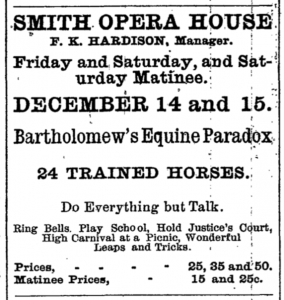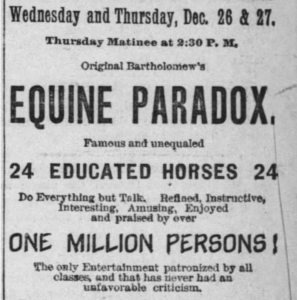SMITH HISTORY BLOG: Horses on the Stage!
by Chris Woodworth
In the early years of The Smith Opera House, audiences could experience an eclectic array of performances. Many of these productions featured unique gimmicks, designed to set productions apart from more traditional modes of performance. Earlier we learned about the performance of Patent Applied For, which brought a horseless carriage onto The Smith stage in 1898. Within months of The Smith opening in 1894, however, the opera house was host to live horses!
In the book A History of Equestrian Drama in the United States: Hippodrama’s Pure Air and Fire,scholar Kimberly Poppiti notes that the use of horses in live performance has gone by several names including equestrian drama, hippodrama, and horse drama and can be traced as far back as the late sixteenth century in England. The use of horses in performance—from theatre to circus to rodeo—has a long and storied history in the United States. It may surprise us today to learn that The Smith stage was one site of equine performance in the late nineteenth century.

Advertisement for performances of Equine Paradox at Smith Opera House, December 14-15, 1894, found in Geneva Advertiser, Dec. 11, 1894, pg. 2
On December 14 and 15, 1894, The Smith hosted the touring production of Bartholomew’s Equine Paradox. In the run up to the Geneva performance, the Geneva Gazetteexcerpted a review of the piece from a recent Philadelphia engagement at the Chestnut Street Opera House. The reviewer described the performance and the remarkable horse performers: “The horses played school, held a trial in humorous fashion, took part in a tug of war, played the ‘Last Rose of Summer,’ and ‘Home Sweet Home’ on bells, played tag, accomplished wonderful leaps at a picnic, and every other thing imaginable, except talk. There was an educated deaf equine and a talking horse, that displayed wonderful ability” (“Bartholomew’s Equine Paradox” 3). Following the Geneva performances, Equine Paradoxalso graced stages in Rochester and Elmira. If the ads for those performances are to be believed, then Equine Paradoxhas “been praised by over one million persons! The only Entertainment patronized by all classes, and that has never had an unfavorable criticism” (“Ad for Elmira Performance” 7).

Advertisement for performances of Equine Paradox at Elmira Opera House, December 26-27, 1894, found in Star-Gazette (Elmira), Dec. 27, 1894, p. 7.
Works Cited
“Ad for Elmira Performance.” Star-Gazette(Elmira), 27 December 1894, p. 7.
“Ad for Geneva Performnace.” Geneva Advertiser, 11 December 1894, p. 2.
“Bartholomew’s Equine Paradox.” Geneva Gazette, 7 December 1894, p. 3.
Poppiti, Kimberly. A History of Equestrian Drama in the United States: Hippodrama’s Pure Air and Fire. Routledge, 2018.